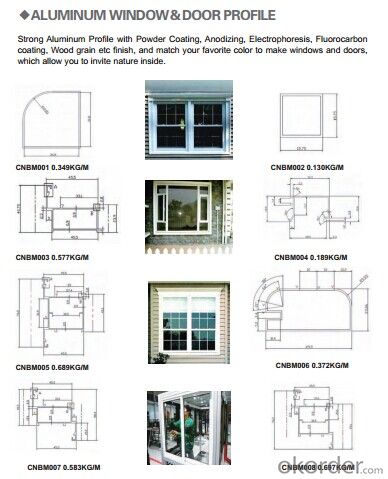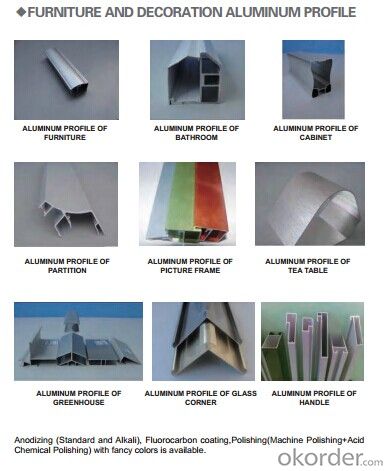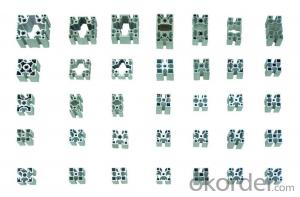powder coated aluminum profile extrusion
- Loading Port:
- China Main Port
- Payment Terms:
- TT OR LC
- Min Order Qty:
- -
- Supply Capability:
- -
OKorder Service Pledge
OKorder Financial Service
You Might Also Like
Aluminium is a relatively soft, durable, lightweight, ductileand malleablemetalwith appearance ranging from silvery to dull gray, depending on the surfaceroughness. It is nonmagnetic and does not easily ignite. A fresh film ofaluminium serves as a good reflector (approximately 92%) of visible lightand an excellent reflector (as much as 98%) of medium and far infraredradiation. The yield strength of pure aluminium is 7–11 MPa,while aluminium alloys have yield strengths ranging from200 MPa to 600 MPa. Aluminium has about one-third the densityand stiffness of steel. It is easily machined,cast, drawn and extruded.
Aluminium alloys (or aluminum alloys; see spellingdifferences) are alloysin which aluminium(Al) is the predominant metal. The typical alloying elements are copper, magnesium,manganese,silicon,tin and zinc. There are twoprincipal classifications, namely casting alloys and wrought alloys, both of which are furthersubdivided into the categories heat-treatableand non-heat-treatable. About 85% of aluminium is used for wrought products,for example rolled plate, foils and extrusions.Cast aluminium alloys yield cost-effective products due to the low meltingpoint, although they generally have lower tensile strengthsthan wrought alloys. The most important cast aluminium alloy system is Al–Si,where the high levels of silicon (4.0–13%) contribute to give good castingcharacteristics. Aluminium alloys are widely used in engineering structures andcomponents where light weight or corrosion resistance is required
Features:
Material | Alloy 6063,6061,6005or according to customer’s choice |
Temper | T3, T4, T5, T6 |
Surface | Anodize, electrophoresis, powder coating, PVDF coating, wood grain painting, matted, etc. |
Length | Coating 6.5 meters, Anodizing 6.5 meters, Mill finish 5 meters |
Application | Industrial, electrical equipment(TV set, air conditioner, refrigerator, computer), decoration,construction, transportation |
Custom Made | We can package following with customer's request. |




FAQ:
1. What is the form of payment?
Normally 30% TT, L/C at sight
2. Type of quotation?
FOB, CFR, CIF
3. Port of loading?
Shenzhen/Guangzhou port
4. Delivery time?
15-20 days after client’s deposit
- Q:Can aluminum profiles be used in load-bearing structures?
- Yes, aluminum profiles can be used in load-bearing structures. Aluminum is a lightweight and durable material that offers high strength-to-weight ratio, making it suitable for load-bearing applications. It is commonly used in construction, aerospace, and automotive industries where its strength and structural integrity are essential.
- Q:How do you cut aluminum profiles?
- If you need to cut aluminum profiles, there are a variety of methods available to you depending on the tools and equipment at your disposal. Here, we will discuss three commonly utilized techniques: 1. Power Saw: To effectively cut aluminum profiles, a power saw like a miter saw or circular saw equipped with a specialized carbide-tipped blade designed for metal cutting is recommended. Adjust the blade to the appropriate speed and angle for your desired cut, and carefully guide the saw through the profile, ensuring a smooth and precise cut. 2. Hacksaw: If power tools are not accessible, a hacksaw is a cost-effective and readily available alternative. Select a fine-toothed blade designed for cutting metal and securely fix the aluminum profile in a vise or workbench. Employ long, steady strokes to slice through the profile, applying gentle pressure to maintain control and prevent blade binding. 3. Shearing: For thinner aluminum profiles, a manual shear can be employed to make straight cuts. Position the profile in the shear, aligning the cutting edge with the desired cut line, and steadily exert pressure on the handle to allow the shear to effortlessly slice through the aluminum. This method is particularly suitable for cutting thinner profiles with precision and minimal risk of distortion. Regardless of the method you choose, it is crucial to wear appropriate safety gear, such as safety glasses and gloves, to safeguard yourself against metal shavings and sharp edges. Moreover, always accurately measure and mark your cut line before initiating the cutting process to ensure your desired outcome.
- Q:What are the different surface texturing options for aluminum profiles?
- Some of the different surface texturing options for aluminum profiles include anodizing, powder coating, brushing, polishing, and sandblasting. These techniques can be used to create different textures and finishes on the surface of the aluminum profiles, enhancing their appearance and providing additional protection against corrosion and wear.
- Q:How is the tonnage of aluminum profile extrusion machine calculated? Do you have any formulas? For example, 30*60 industrial profiles, the need for a large tonnage of extrusion machine can be done?
- This section is almost the same as a 1500-2000 ton extruder.In general, the extrusion ratio of 6063 profiles will be controlled at around 30-150,That is, the section of rice weight / casting rod of rice weight, or section section area / aluminum bar cross-sectional area.
- Q:Are there any limitations or drawbacks of using aluminum profiles?
- Yes, there are some limitations and drawbacks of using aluminum profiles. One limitation is its lower strength compared to other materials such as steel. Aluminum profiles may not be suitable for heavy-duty applications that require high tensile strength or load-bearing capacity. Therefore, in certain scenarios, steel or other materials may be preferred. Another drawback is that aluminum is more prone to corrosion compared to materials like stainless steel. Although aluminum profiles can be treated with protective coatings, they may still be susceptible to corrosion in harsh environments or if not properly maintained. This can affect their durability and longevity. Furthermore, aluminum profiles may have higher initial costs compared to other materials. The production and processing of aluminum can be more expensive, which can impact the overall cost of using aluminum profiles in construction or manufacturing projects. Lastly, aluminum profiles may have limitations in terms of design flexibility. While aluminum is relatively easy to shape and mold into various profiles, it may not be as versatile as some other materials. This can limit the options available for complex or intricate designs. Despite these limitations and drawbacks, aluminum profiles still offer many advantages such as lightweight construction, excellent thermal conductivity, and resistance to electrical conductivity. Therefore, it is essential to carefully consider the specific requirements and constraints of a project before deciding to use aluminum profiles.
- Q:What are the industries that require aluminum profiles in industry?
- 10, furniture aluminum profiles are mainly used for furniture decorative boxes, tables and chairs, support components11, solar photovoltaic solar energy profiles include: aluminium frame, solar photovoltaic, solar photovoltaic and other fastener scaffold.12, rail vehicle structure aluminum alloy profile: mainly used for rail vehicle body manufacturing. Aluminum alloy profiles have the characteristics of light weight, good formability, high strength, corrosion resistance and recycling. In recent years, aluminum and aluminum alloys have been used more and more widely in the field of rail vehicles.13, Mount Aluminum Profiles: made of aluminum alloy frame, mounting a variety of exhibitions, decorative paintings.14, medical equipment aluminum profile is mainly used in: stretcher frame, medical equipment, medical bed, etc..
- Q:How much is aluminum freight per kilometer per ton?
- The most accurate and effective way of Logistics: find a phone call to ask ah, less than 1 tons and tons of vehicle and hair are not the same, where to go is not the same, some small place to transfer is much more expensive, General Logistics 1 tons in about 500
- Q:How do aluminum profiles contribute to LEED certification?
- Aluminum profiles contribute to LEED certification by being a sustainable and environmentally-friendly material. They can be easily recycled and have a low carbon footprint. Additionally, aluminum profiles are energy-efficient, as they allow for the use of natural light and reduce the need for artificial lighting. Their durability and long lifespan also contribute to reducing waste and the need for replacements, further enhancing the building's overall sustainability.
- Q:Can aluminum profiles be used for soundproofing?
- Yes, aluminum profiles can be used for soundproofing. Aluminum profiles can be combined with soundproofing materials such as acoustic foam or rubber gaskets to create an effective sound barrier. Additionally, aluminum profiles have the advantage of being lightweight and easy to install, making them a practical choice for soundproofing purposes.
- Q:What are the different surface engraving or etching techniques for aluminum profiles?
- Some of the different surface engraving or etching techniques for aluminum profiles include laser engraving, chemical etching, mechanical engraving, and sandblasting. Each technique offers unique benefits and can be used to achieve different aesthetic effects on the aluminum surface.
1. Manufacturer Overview |
|
|---|---|
| Location | |
| Year Established | |
| Annual Output Value | |
| Main Markets | |
| Company Certifications | |
2. Manufacturer Certificates |
|
|---|---|
| a) Certification Name | |
| Range | |
| Reference | |
| Validity Period | |
3. Manufacturer Capability |
|
|---|---|
| a)Trade Capacity | |
| Nearest Port | |
| Export Percentage | |
| No.of Employees in Trade Department | |
| Language Spoken: | |
| b)Factory Information | |
| Factory Size: | |
| No. of Production Lines | |
| Contract Manufacturing | |
| Product Price Range | |
Send your message to us
powder coated aluminum profile extrusion
- Loading Port:
- China Main Port
- Payment Terms:
- TT OR LC
- Min Order Qty:
- -
- Supply Capability:
- -
OKorder Service Pledge
OKorder Financial Service
Similar products
New products
Hot products
Related keywords































